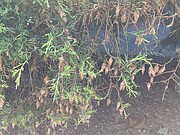Q: Bagworms got ahold of our evergreen shrub (see reader's photo). I've sprayed and (I think) killed them off. There are hundreds! Do I need to pick them all off? Will my shrub recover?
A : I know you don't want to hear this, but, yes, it will help if you can pick off as many as possible. Sprays are usually not very effective once the bags are totally constructed and the plant damage is done. These tiny insects started feeding in May. As the larvae crawls and feeds, they construct the sack or bag around their body to protect them from predators and insecticides. They are typically in their crawling/feeding stage for about a month from mid-May through June, depending on the weather. The key is to apply the insecticides according to label directions from mid-May through mid-June when the bagworms are in their juvenile stage and before the individual bag or sac is constructed. They prefer needle-type evergreens such as junipers and cedars, but will branch out to other shrubs as well. Handpicking and destroying the bags can cut down on problems next year for neighboring plants. If you have bagworms every year, you may want to implement a spray program on the needle-type evergreens starting in mid-May. One application a week with BT (Bacillus thuringiensis) or similar insecticide will work. Three applications a year should suffice. Your juniper will take a few years to recover and fill in. Needle-type evergreens only have new growth buds where there are green needles. If you have any branches that are dead from top to bottom, prune those out as you remove the bagworms. Good luck.
Q: I planted an Encore azalea this spring to replace some that were damaged. When I planted it, it had lots of blooms. Those are the only blooms it has had. I have kept it well watered. The bush looks fine but no summer blooms. Can you give me some suggestions? It was supposed to bloom nonstop.
A: Encore azaleas will not bloom nonstop. They usually have a good display in the spring and an even better display in the fall. Occasionally, scattered blooms will appear in the summer, but it is the fall reblooming that is the selling point. Newly planted azaleas will be taking time to get a root system established, and hopefully you will see plenty of blooms this fall. My plants are well established, and I do have some blooms now, but they will really shine this fall.
Q : Any thoughts on why this 10-year-old filbert is in decline (see reader's photo). Some leaves turn brown, and it hasn't bloomed much. I have noticed some spider webs.
A: It doesn't look as full as it should be. How much do you prune to keep it open? Regular spiders are not a concern. Tiny webbing can indicate spider mites, which can interfere with good growth. Winter took its toll on a lot of our landscape plants two years ago and many are still recovering. I have noticed some plants that we thought had rebounded and survived that are actually declining this season -- some were not watered well last season. A little extra TLC can help. It is too hot to fertilize now, but if it cools off, a light application of fertilizer and ample water are all you can do. I don't see any spots on the leaves, so I don't suspect disease, but continue to monitor and hope for the best.
Q: Our hydrangeas bloomed after growing tall and old flowers are mostly dried and drooped to the ground. When and how much do we cut them back? Neighbor says he just cuts off dried flowers, but our plants are much too tall. We need your expert advice.
A : What a good problem to have. We did have spectacular blooms on our big leaf hydrangeas this year, after two years with little to none. Since our plants did not bloom last year, they didn't expend any energy on flowers, so grew foliage only. If they need to be pruned, do so now. Big leaf hydrangeas bloom in the summer, but set flower buds in the fall. Thin out some of the tallest canes to the soil line, and then do some selective pruning on the remaining stems. This should give you shorter sturdier stems, and blooms next season.
[Gallery not loading above? Click here for more photos » arkansasonline.com/carson713/]
Retired after 38 years with the University of Arkansas Cooperative Extension Service, Janet Carson ranks among Arkansas' best known horticulture experts. Her blog is at arkansasonline.com/planitjanet. Write to her at P.O. Box 2221, Little Rock, AR 72203 or email jcarson@arkansasonline.com

